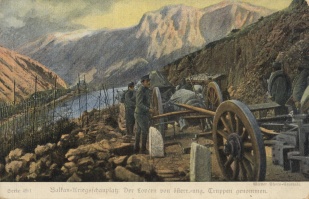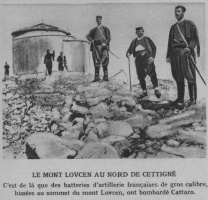Lovćen: Montenegro’s Mount Doom↑
Mount Lovćen (42°23'56"N, 18°49'5"E) is part of the Dinaric Alps, situated in Montenegro between the Bay of Kotor (Bocche di Cattaro) and the Southern Adriatic Sea. The eye-catching karst massif, with its steep and rocky slopes, has two peaks: Štirovnik (1,749 metres) und Jezerski Vrh (1,657 metres).
Since 1854, the Habsburg Empire had maintained a naval base in the deeply indented Bay of Kotor at the foot of the Lovćen – one of the best natural harbours in the world. But Kotor’s strategic value was diminished, if not neutralized, by the Montenegrin outposts on the Lovćen, ideally suited to observing and threatening the Austro-Hungarian naval facilities.
Combat Operations and Politics↑
On 8 August 1914, outdated Montenegrin artillery on the Lovćen commenced shelling the Austro-Hungarian fortifications, which returned fire. Finally, the Montenegrins were outgunned by Austro-Hungarian pre-dreadnoughts. On 18 September 1914, a French detachment with eight naval guns destined for Mount Lovćen landed in Stari Bar (Antivari). Due to difficulties in transportation, the French artillery did not fire before 19 October 1914; the Austro-Hungarian battleship Radetzky soon silenced them. On 26 October 1914, the French and Montenegrins abandoned their artillery positions on Mount Lovćen.
After several months without significant combat operations in the region, the Lovćen again became the centre of the military operations: After Austria-Hungary, Bulgaria and Germany had defeated Serbia at the end of 1915, the Austro-Hungarian army attacked Montenegro. Between 7 and 10 January 1916, the 47thInfanteriedivision, closely backed by naval artillery, conquered the Montenegrin positions at the Lovćen, which the Lovćenski Odred had defended. The fall of Lovćen demoralized the Montenegrin forces; a counteroffensive failed due to insubordination and mutinies. The Montenegrin army requested an armistice, but the Austria-Hungarian forces continued their offensive and seized Montenegro’s capital, Cetinje, on 13 January 1916.
The elimination of enemy positions on the Lovćen allowed the Central Powers to maximize use of the Bay of Kotor. The bay became the main base for the Austro-Hungarian cruiser flotilla; Austro-Hungarian and German submarine facilities were expanded. During the three years of the Austro-Hungarian occupation, Mount Lovćen was arguably the best guarded location in Montenegro.
The annexation of Mount Lovćen was a central war aim of Austria-Hungary. Charles I, Emperor of Austria (1887-1922) even included it in his “minimal programme” of 12 January 1917, along with the guarantee of the Habsburg Empire’s territorial integrity and a dynastic change in Serbia.
Mountain Wreath↑
In 1851, Peter II, Prince-Bishop of Montenegro (1813-1851) – called Njegoš – was buried in a small chapel on Jezerski Vrh. As a politician, Njegoš was considered the founder of the modern Montenegrin state, but first and foremost he was revered as one of the most prominent Serb poets and author of the Montenegrin national epic "The Mountain Wreath" ("Gorski Vijenac"), in which the Lovćen plays a central role.
The Austro-Hungarian plans to fortify Mount Lovćen in order to protect the Bay of Kotor endangered Njegoš’s burial chapel. Thus, on 12 August 1916, Njegoš’s corpse was solemnly – under supervision of the Orthodox clergy – transferred to the monastery in Cetinje without much further ado. The Austro-Hungarians additionally hoped that Serb pilgrims would cease to visit the Lovćen. Njegoš’s remains were returned to the Jezerski Vrh in 1925. In 1970, they were buried in a monumental mausoleum designed by Ivan Meštrović (1883-1962).
Miscellaneous↑
The Austro-Hungarian generals Ludwig Koennen-Horák von Höhenkampf (1861-1938) and Stjepan Sarkotić von Lovćen (1858-1939) received their noble names in recognition of their merits during the capture of Mount Lovćen in January 1916. During the Yugoslav era, the Bay of Kotor remained an important military port. After Montenegro’s independence in 2006, the military installations were dismantled.
Heiko Brendel, Johannes Gutenberg Universität Mainz
Section Editor: Tamara Scheer
Selected Bibliography
- Brendel, Heiko: Der geostrategische Rahmen der österreichisch-ungarischen Besatzung Montenegros im Ersten Weltkrieg, in: Angelow, Jürgen / Gahlen, Gundula / Stein, Oliver (eds.): Der Erste Weltkrieg auf dem Balkan. Perspektiven der Forschung, Berlin 2011: be.bra wissenschaft verlag, pp. 159-177.
- Enne, Peter: Die österreichisch-ungarische Offensive gegen Montenegro 1916 unter besonderer Berücksichtigung der Operation über den Lovćen und des Zusammenbruchs der montenegrinischen Armee, Vienna 2008: Universität Wien.
- Halpern, Paul G.: The naval war in the Mediterranean, 1914-1918, Annapolis 1987: Naval Institute Press.
- Rakočevic, Novica: Crna Gora u prvom svjetskom ratu 1914-1918 (Montenegro in the First World War 1914-1918), Cetinje 1969: Istorijski Institut Titograd.
- Wachtel, Andrew B.: How to use a classic. Petar Petrović Njegoš in the twentieth century, in: Lampe, John R. / Mazower, Mark (eds.): Ideologies and national identities. The case of twentieth-century Southeastern Europe, Budapest; New York 2004: Central European University Press, pp. 131-153.










